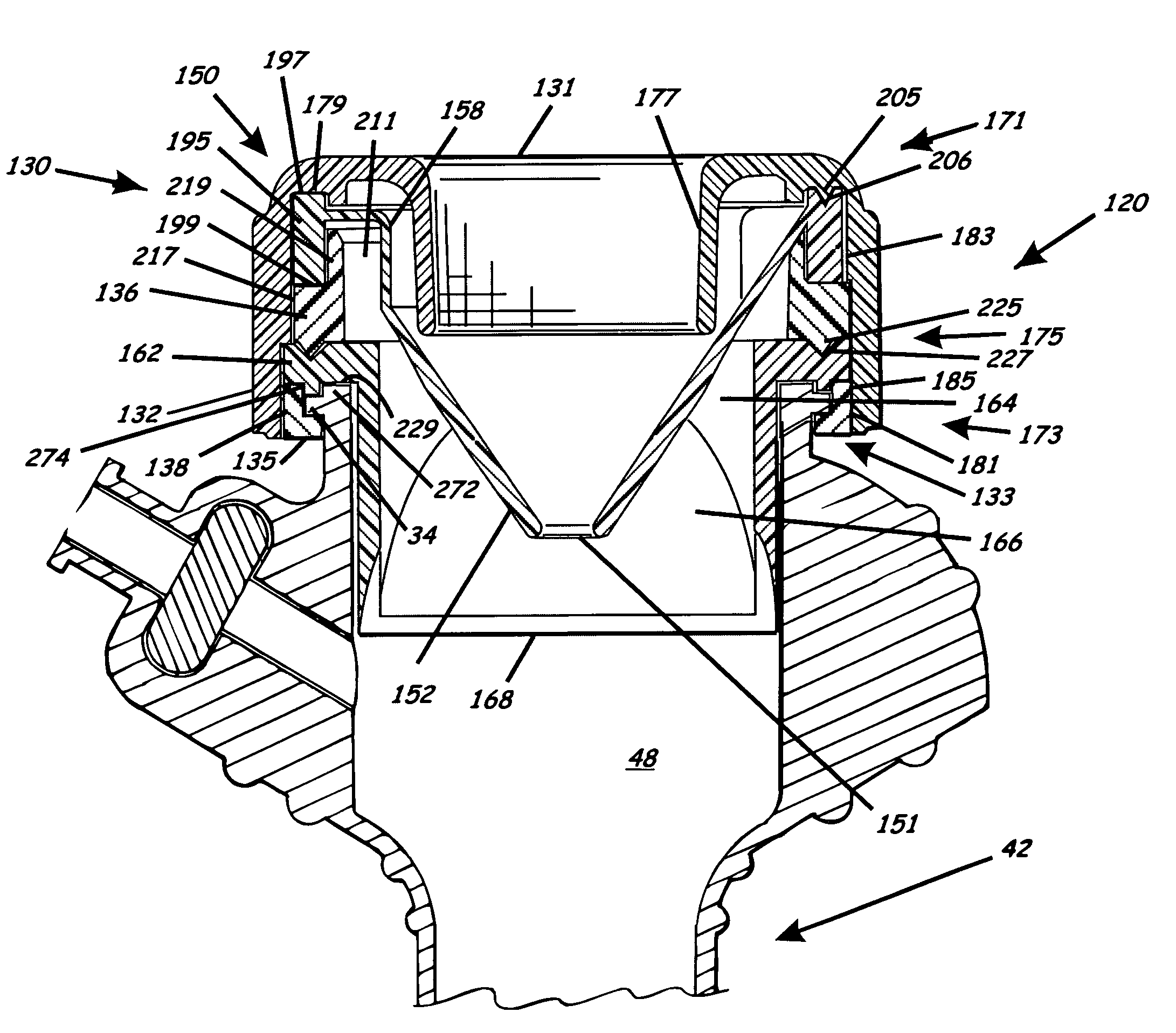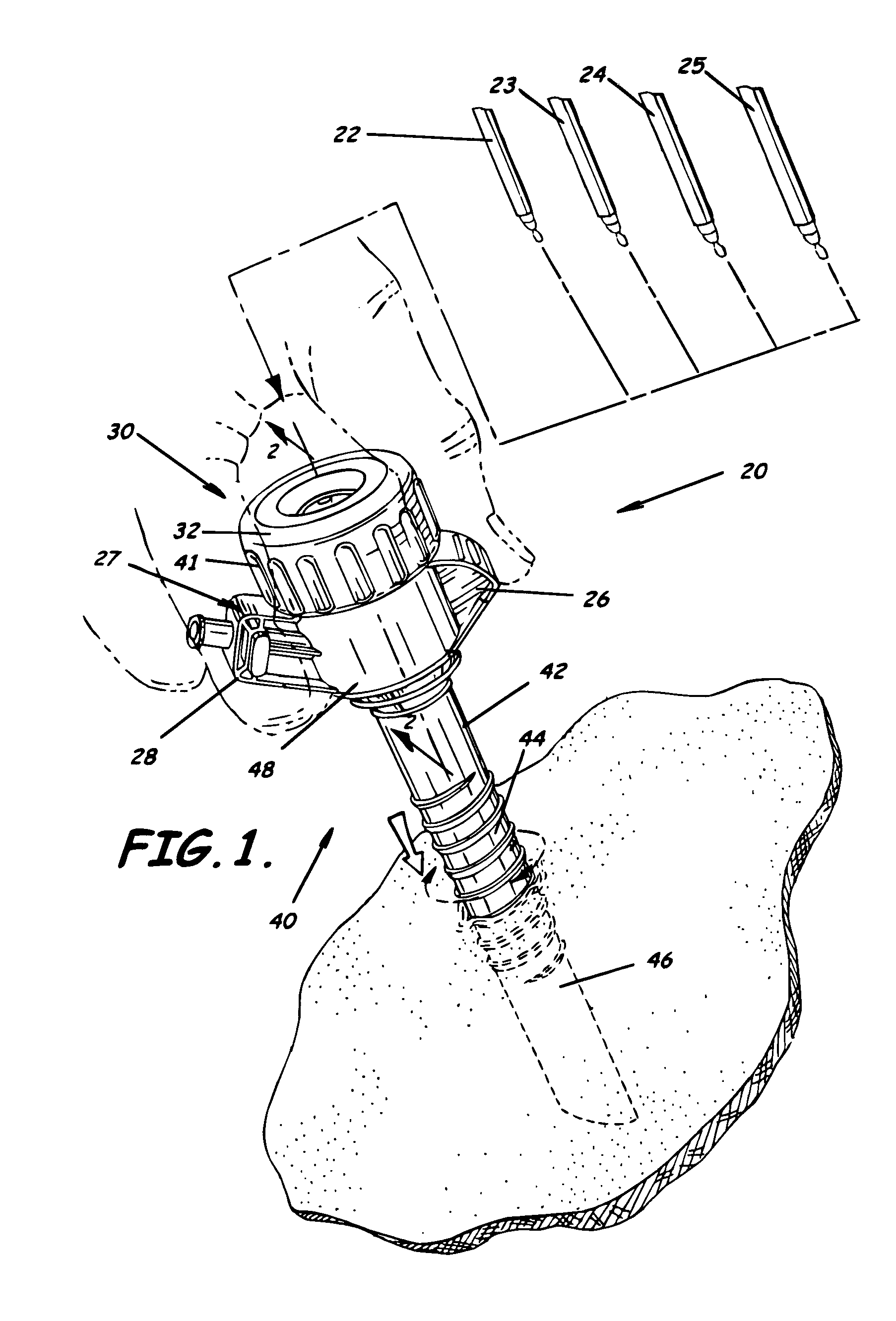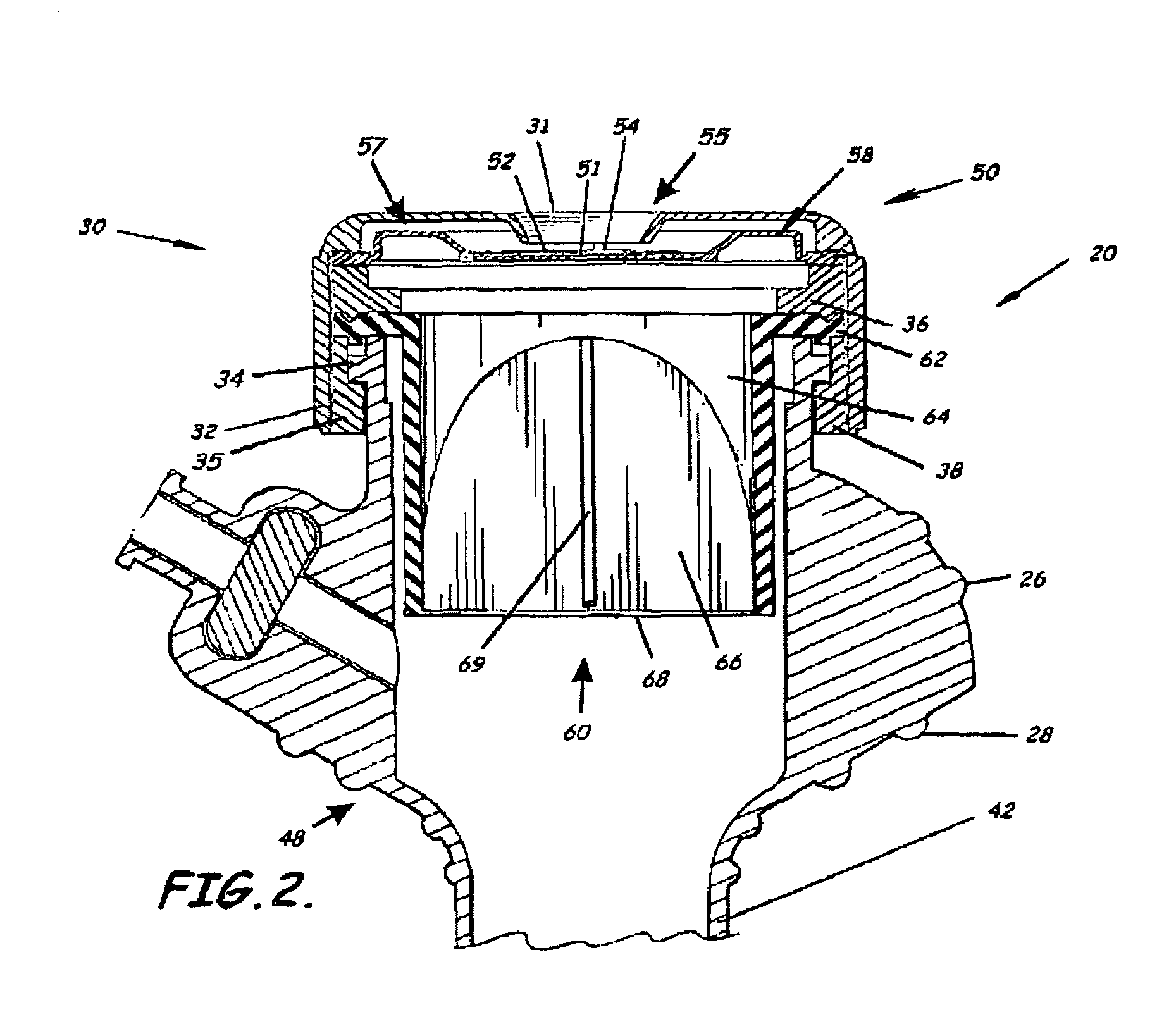[0007]With the foregoing in mind, embodiments of the present invention advantageously provide embodiments of a valve having a unique design to provide a secured seal around a plurality of tools that individually and separately extend through the valve. Embodiments of a valve provide an easier
insertion and retraction, of various laparoscopic surgical instruments as well as other surgically related items which have varying diameters. Problematical instruments do not get obstructed or caught in a multi-component valve assembly as disclosed in the prior art. Embodiments of the present invention also advantageously provide a trocar
system having relatively low costs associated with the manufacturing of components of the
system, e.g., valves, and thereby can reduce the cost associated with the trocar system. Embodiments of the present invention additionally advantageously provide a more flexible trocar system which is effective during various endoscopic
surgical procedures. Embodiments of the present invention further advantageously provide enhanced methods of forming a seal around tools and of using a trocar system during
surgical procedures. Still further, because embodiments of a valve can have a relatively flat and thin profile and because peripheries of a valve are fixedly connected to a valve housing, the valve advantageously can operate like a membrane. Furthermore, because various types and diameters of tools can be used by medical personnel, embodiments of a valve advantageously allow one type of valve, cannula, or trocar system to be readily used for all of these various sizes and types of tools.
[0013]The first valve can also include a compression ring positioned in the valve housing abuttingly contacting an axially facing distal surface of the valve ring to hold the valve ring in the valve ring recess and to compress the valve ring against an axially facing inner surface of the proximal end housing portion of the valve housing adjacent the valve ring recess in order to fixedly position the valve within the valve housing. The compression ring can include a compression ring opening substantially aligned axially with the first opening of the valve housing to allow extension of the plurality of elongate tools therethrough, an outer perimeter surface having a radial
diameter sized so that the compression ring substantially abuttingly contacts the distal valve housing inner perimeter surface when positioned within the valve housing, and an annular
flange extending into each one of the plurality of convolute recesses to individually and separately engage a corresponding one of the plurality of convolutes to further enhance positioning and securing of the first valve within the valve housing.
[0014]The cap assembly can also include a second valve to advantageously help ensure inter-cavity sealing. The second valve can include an annular
flange portion spaced axially from the valve ring of the first valve and having a radial
diameter sized so that the annular
flange portion substantially abuttingly contacts both the distal valve inner housing perimeter surface and an axially facing distal surface of the compression ring adjacent the compression ring opening to enhance positioning of the second valve at least partially within the valve housing. The second valve can also have a second valve opening positioned within the annular flange portion and substantially aligned axially with the first opening of the valve housing to allow extension of the plurality of elongate tools therethrough, an annular-shaped sidewall connected to the annular flange and extending distally in a substantially axial direction when positioned in the valve housing, and a pair of valve flaps connected to and extending inwardly from the annular-shaped sidewall and having at least one slit along common
peripheral edges thereof through which the plurality of tools extend individually and separately. The second valve can be held in place through use of a cap seal ring positioned at least partially within the valve housing and positioned to abuttingly contact a distal surface of the annular flange portion of the second valve when the second valve is positioned in the valve housing. The cap seal ring can have an axially extending annular-shaped flange axially spaced apart from the compression ring to provide a slot or recess to releasably receive the annular flange portion of the second valve. The cap seal ring can also include a plurality of radially extending flanges each adapted to engage outer peripheries of a separate one of the plurality of radially extending flanges of the cannula to slidably detachably connect the valve housing to the cannula.
[0015]Embodiments of the present invention also include methods of using a trocar system. For example, according to embodiment of a method, the method includes the step of providing a cap assembly in a trocar system. The cap assembly has a septum valve including a valve body having an annular-shaped valve opening positioned in a medial portion of the valve body adapted to receive individually and separately a plurality of tools therethrough so that when any one of the plurality of tools is positioned through the valve opening abuttingly contacting outer peripheries of the any one of the plurality of tools extending therethrough a septum seal is maintained between peripheries of the valve body surrounding the valve opening. The valve body can include first and second
layers of a fabric material and a layer of elastomeric material positioned between and contacting each of the first and second
layers of the fabric material, and can include a periphery valve section connected to and extending radially outwardly from peripheries of the valve body and having an outer perimeter thereof adapted to be fixedly connected to the valve housing. The periphery valve section can also have a plurality of rib members each radially extending substantially an entire distance between an outer perimeter of the valve body and the outer perimeter of the periphery valve section and symmetrically positioned spaced-apart from each other. The periphery valve section can have a greater flexibility than the valve body.
[0019]Another embodiment of the method of forming a valve for a trocar system can include first inserting a valve having a valve body into the valve housing. A compression ring, for example, coated with an
ultraviolet bonding agent, is then placed into the valve housing adjacent and abuttingly contacting the valve in a “stacked” fashion. Following this, the second valve is inserted into the valve housing adjacent and abuttingly contacting the compression ring, and a cap seal ring coated with an
ultraviolet bonding agent is placed into the valve housing abuttingly contacting outer peripheries of the second valve. Both the compression ring and cap seal ring can be coated with an
ultraviolet bonding agent along the outer peripheries thereof abuttingly contacting the inner peripheries of the valve housing. Once each of the components is in its place, the entire cap assembly is placed in a
compression system, wherein each component is compressed to its desired depth into the valve housing. At that point, an
ultraviolet light is exposed to the ultraviolet bonding agent to cure the materials. Upon the completion of the curing, the cap assembly is formed as one unit. Beneficially, the second valve can be readily removed and exchanged for a replacement.
[0020]When constructing a trocar system, the cap assembly is abuttingly and releasably connected to a cannula. The proximal end portion of the cannula body has at least one valve housing
mating portion associated therewith and the cap seal ring positioned in the valve housing also has at least one cannula body
mating portion or flange associated therewith so that the cap assembly matingly attaches to the cannula body in a secured position and whereby movement of the cap assembly, e.g., rotation, by a hand of a user, releases, e.g., unsecures or unlocks, the respective
mating portions for ready removal of the cap assembly by the user with the valve and second valve and so that specimens, e.g., tissue, can be readily removed from the cannula body without damage by the first and second valve. Advantageously, the extraction of large tissue samples and / or gauze packs can be accomplished without removing the cannula from the area where various endoscopic procedures take place.
 Login to View More
Login to View More  Login to View More
Login to View More 


